|
TennisOne Lessons Body Works: Getting the Body into the Shot Doug King In my mind the fundamental difference between how the game is played today versus how we have always taught the game is the shift of power out of the racquet and into the body. We have always been told, “Get your body into the shot,” but I would suggest that the commonly held principles of how this happens are quite misunderstood. In fact the conventional wisdom of getting the body into the shot often produces the opposite effect. Instead of getting the body into the shot, the commonly recommended techniques simply get the body in the way of the shot.
In the first part of this series on Body Mechanics we will look at the body from a structural perspective, how power is generated, and how we use this energy in a manner that produces the correct response of the ball on the strings. In the second part we will look at the dynamics of body motion and its implications to balance and perspective. The Nature of Contact Before we go any further let’s take an overview of the general picture of how a ball is stroked in tennis. We will start with the essence of the stroke - the precise moment of contact between the ball and the strings. The nature of contact is spring. When a ball is hit the ball compresses and deforms both the string bed and itself. After deformation the string bed and the ball spring back to their natural states. These objects are by nature “elastic” and it is in this elastic collision and the ensuing transformation out of and return back into natural shape, that energy is exchanged. In this relatively short period of time (approximately 5/1000ths of a second) a tremendous amount of change occurs between the ball and the strings. There is a trampoline effect between the ball and string bed during this collision. The ball squishes into the strings, pushing them backwards and flattening out the ball in the process. The strings then spring back, shooting the ball out while the ball springs back into shape. During this process energy is exchanged between the ball and the strings. The whole purpose in stroking is to manipulate this exchange of energy. The hand and wrist is the first place this exchange can be managed, but the entire body plays into the energy exchange in very significant ways. The secret to stroking lies in this spring exchange between the ball and the strings and being able to get the entire body, through feel, timing, and technique, to mimic and manage this response. The Nature of the Game
The second basic concept to understand is the nature of the game of tennis itself. What kind of contact are we trying to produce to make it conform to the constructs of the game (i.e., the court, the net, the ball and the racquet)? In my previous article (The Roll Model) I explained that the desired action emanating from contact should be a rolling action of the ball as opposed to a direct hit of the ball. This will produce the required control demanded in more effective play. Thus, in the natural spring collision between the ball and racquet there is also an element of turning that should deliberately be applied to the process for maximum efficiency. This ball turning is achieved by creating diverging paths between the ball and racquet as they approach collision. The ball and racquet will therefore “bite” and rotate. Imagine two spongy gears moving towards each other, both rotating as they approach, colliding with each other, engaging and rotating, and springing back out away from each other. This is similar to the ball and racquet interaction. The swing path is arced and that path represents one gear. The racquet face is a section of this large, imaginary gear. We call this large, imaginary gear the “swing path.” How the Body Works The third concept to examine is the anatomical structure of the body. I like to use an analogy that compares the body parts to a series of gears, pistons, hinges, springs, and levers. If we evaluate the body’s structure from the ground up, we can say that the legs act as springy pistons. They are also the support for the body, holding it up and putting it in contact with the ground (see more on ground force later). The legs connect to the hips, which can be seen as a rotational plate or gear. The hips are connected to the shoulders, which form another plate or gear. The arms attached to the shoulders, and can be seen as pistons or whips. As we move further from the ground along the body structure, we increase in the body’s flexibility and range of movement. The shoulders sitting on top of the spine are much more flexible in their range of movement than the hips, which are more stable. The arms are the loosest part of the structure and have a wide range of movements and actions. They are not only pistons but they can also swing and rotate. So we have power and stability at the base, and we have softness and flexibility extending out. In this structure we have both driving force (pistons) and rotational force (gears), and in a wide range of movements and dimensions.
Ground-Force The fourth concept to understand in this model is ground-force. The ground is the springboard of power in the body. If the body is to act like a spring to mimic the spring of the ball and strings, then the ground is the thing that the body spring is compressed against. Imagine trying to hit a ball while floating in water or in the vacuum of space where there is no resistance. It would be very difficult for the body to contribute to the force imparted to the ball since the body has little to compress and push against. The body can produce both the driving (spring) action and rotational (gear turning) action that is required for perfect ball response. The ground provides the resistance that the body springs and rotates off. The trick in tennis is to coordinate the natural body and ground forces so that they align to the ball and target and can precisely attune to the natural spring and turn of the ball at contact. Now let’s look at how that is achieved. Spring and Turn — The Two “Contact Points” The summary phrase for proper contact is “spring and turn.” The ball springs out of the racquet and is turned by the racquet. At the same time the body makes this same action off of the ground — spring and turn. (Note that spring “off” of the ground does not mean that you necessarily “leave” the ground and, especially on low balls, this spring action is minimized due to alignment demands. Further, I will use the term "spring" in reference to the body because it conveys a softness that encourages relaxation, a necessary component to efficient movement, although thrusting and pushing are more precise terms when referring to straightening body actions.) The spring and turn off of the ground produces thrust and momentum, upward lift and forward rotation. The spring of the body is on a vertical plane, producing lift, while the turn of the body is on a horizontal plane, producing forward momentum. When the legs drive up and the hips rotate forward, the ground does not yield so the body thrusts and turns with relative force. On the other hand, the racquet spring and turn of the ball is of a different nature. The push/spring is on a more horizontal plane while the turn is on a more vertical plane. Also, the ball yields to the spring and turn of the racquet so there is “follow” involved in this action, what we call “follow through.” And even though the ball has a natural trampoline action off of the strings, the body is still actively participating in the thrust and lift of the entire racquet. Still it is important to see this ball-and-racquet connection as a “spring against the ball” as opposed to a “swing through the ball.” In the final analysis we have two “Contact Points” — the ball and the ground. We are springing and turning off of both Contact Points, almost like platforms. One does not yield (the ground) and provides for a forceful drive of the body, while the other (the ball) yields and responds much more to the forces of momentum, direction, and rotation transferred through the racquet. These two contact points create a complete circuit of energy. Again the critical thing to remember is that you are not trying to swing at the ball, through the ball, or off the ball. You are trying to create contact with the ball and “spring off” of it and turn it using the racquet in the same way that you are trying to make contact with the ground and spring off of it and turn the body using the feet and legs. Imagine you are sitting on a large concrete seat at a small, light table that is on wheels. You decide to get up and so you push up out of the chair (which doesn’t move) and you push out against the table (which slides away). You wouldn’t swing at the table to move it but you would hold contact with the table and use the force of the ground as the main source of power. The harder and faster you spring up and push the table, the faster the table moves away. Now imagine turning integrated into the equation (a bit of a stretch in this analogy but I did say imagine). That is very similar to how a tennis stroke should feel. Energy Release: The Power Cord and the Power Pocket As spring and turn is a combination of the natural and desired effect of the ball off of the racquet, the same is true for the release of power out of the body. In the first video (above) I use a ball tucked into a towel to demonstrate how energy is released out of body. If the ball is tucked into a formed pocket in the towel, that ball can be shot out of the towel by moving the towel forward and pulling the towel straight simultaneously. In the same way, when the arm falls in close to the body (slotting), the body can shoot the arm away by moving forward and straightening. In the case of the body, the forward movement is achieved not by stepping forward (as this is slow) but by rotating forward (Imagine how fast an ice skater can spin versus the speed achieved by stepping forward). So the release of power from the body is achieved by rotating back and flexing, dropping the arm (elbow) into the pocket formed by the bend at the waist, and then straightening the back and turning forward. This will release energy out of the body that will naturally drive the arm up and away from the body, while the arm remains relatively passive; much like the ball remains passive in the towel. The hitting side of the body (right side for right-handed forehand and one-hand backhand — left side for two-handed backhand) is the towel. This is what I call the “Power Cord.” The pocket that is formed when the body is bent is the “Power Pocket.” The forearm and hand rest into the Power Pocket and smoothly make contact (connection) with the ball while the body springs and turns to release energy that drives the arm. When the spring and turn of the body attunes to the natural spring and turn of the ball off of the strings, we are in perfect sync with body and ball. Pulling the Stroke Together By understanding the basic anatomical nature of the body (power based/stable lower body and flexible/dexterous upper body), we can conclude that the most efficient equation is to achieve an infusion of power into the hips/legs and suppleness or feel into the arms/hands. The legs and pelvis are the center for power whereas the hands are the delicate, control sensors. We say the legs and hips do the gross motor powering and the hands do the fine motor control.
In proper stroking what we want to attain is a concentration of power in the legs and pelvis (drive) while the hands stay relaxed and precise (touch). When we swing the racquet at or through the ball we are using the hands in a powering capacity as opposed to a control function. The hands should never feel the racquet “swinging.” Instead the hands should feel the racquet aligning to the ball, catching, gripping, or absorbing the ball, and then turning the ball. The actual propulsion of the ball should be felt in the feet, legs, hips and shoulders. This may seem unnatural but in reality this is how most balls are propelled in sports. Think of a basketball jump shot; the legs and body power the shot while the hands do the aiming and turning of the ball. The same principle applies to a tennis stroke. We don’t often feel this because we are conditioned to think that the "swing" of the racquet is the natural source of power in the tennis stroke. We are told to take the racquet back, to step forward, and to follow through. Racquet speed is the rule. In reality this goes against all fundamental principles of anatomy, coordination, and the basic nature of tennis contact. I always tell my students to feel as though the hands make the ball “stay” with you while the feet and hips make the ball “leave.” The trick is to coordinate these two feels and functions into a single stroking movement. The stroke movement requires power and touch to drive the ball accurately, stability to repeat it consistently, and fluidity to flexibly adjust it to the changing conditions of the ball and court position. This can happen almost naturally with the correct grips. Let's see how this works.
If we breakdown the flow of movements in a typical stroke starting with the ready position we will see how using the correct grips can be key in learning to properly direct energy into the right places; more power to the hips and more feel in the hands. Taking a typical forehand stroke we will see that almost all professional players hold the racquet face closed on take back. This would be achieved by taking a full Eastern or more commonly a semi-Western grip. The initial turn will naturally direct energy into the arms and will extend the arms back slightly and away from the body. In fact, the shoulders/arms can swing out and lift in a controlled way to assist the lower body turning action, as they are loose and can move more easily. In this initial turn the racquet face is still in a closed position with the racquet head above and in front of the hand (note — be sure to keep both hands on the racquet here). As the ball approaches the racquet must eventually be brought into a hitting position that aligns the racquet face into a contact position. This alignment is achieved by rotating the forearm inward and forward. I call this change in the alignment of the racquet face from a horizontal closed position to a vertically aligned square position a “plane inversion” as it feels as though the stroke is being turned inside out. This same rotation of the forearm not only squares the racquet face but it also forces a drop of the racquet head behind and below the hand. So in order to square the racquet face the elbow is pulled forward and into the hip (the Power Pocket) while the racquet is rotated back and down. This movement directs forward momentum into the hips, compacting the arm into a very strong and quick position close to the body, while at the same time causes a backwards movement of the racquet head in the hand. This racquet face inversion (forearm rotation) is also an “energy inversion” as it draws the momentum of the stroke out of the racquet head and into the hip and hitting side of the body.
I tell my students to feel a firm pull of the elbow into the hip while the racquet head “spills” out of the hand and down towards the ground, where it remains for the rest of the stroke. (This is a figurative metaphor as subtle accelerations of the racquet will occur naturally from the hand as it involuntarily tightens just prior to contact and due to the natural spring impulse of the ball into the strings — but conscious effort should be directed toward keeping the hand and racquet relatively passive and stable against the ball). The other thing that proper grips and slotting achieves is a reorientation of the upper body from horizontal to more vertical. When the stroke begins (ready position) the shoulders are level to the ground but by the time the ball is being hit the shoulder are much more tilted. This is because the correct grip forces a dipping in order to get the racquet face square. This dip is what allows the racquet to intersect the ball with a lifting/rolling action. With the shoulders tilted the roll of the ball comes very naturally. Remember the shoulders are flexible so they can accommodate this dip much more easily than the hips, which remain more stable and solid through the stroke. So in this inversion we have the racquet head and hand and the left (non-hitting) side making a backward, receding action, while the momentum of the stroke is forced into a forward drive of the right side on a more horizontal plane. The upper body and racquet head make a collapsing, receding action and become more passive and vertically oriented, while the forward momentum is driven into the hips in a compacting, slotting” action into the “Power Pocket” formed by the bend at the waist. This is the feeling of a smooth pulling of the butt of the racquet forward at the oncoming ball.
The motion is completed with a mainly vertical lift of the racquet through contact, as both the knuckles and the shoulder of the hitting side are lifted through the contact zone. The feeling is that the racquet handle is actually being lifted first by the shoulder, and then by the knuckles, as the back straightens through contact. The racquet itself is held very passively, allowing the hand to do its job of holding contact. This produces a natural forward roll (topspin) on the ball. The amount of lift versus forward thrust will vary depending upon the desired spin/speed ratio desired. The overall motion achieves the required elements of power, touch, fluidity, and stability. By using the correct grip the arm will naturally slot in the Power Pocket, engaging both the arm and force into the hip (the Power Gear). This injects power where it should be located, providing stability to the body which, in turn, allows the hand to stay supple for proper touch and control. If the arm does not engage in the hip it will get whippy and swingy and lose both touch and stability. As the arm engages in the Power Gear of the hip the shoulders will also work in unison with the hips, although on more of a vertical axis to provide proper turning of the ball, while the hips remain more horizontal, providing forward force through rotation. In essence, the shoulders and hips work almost like two angled gears, one on a horizontal rotational plane and the other on a more vertical rotational plane. A condensed sequence of the stroke would be as follows: From Ready Position:
Shadow Play: Practice Reinforcement To integrate proper stroking patterns into your play it is important to develop a proper mental image and motor feel. This can be done through “shadow play.” Much like a boxer rehearses the movements of bobbing and weaving, punching and ducking, so should a tennis player rehearse the movements of the tennis stroke and game play.
I advise my students to shadow the stokes in series of ten repetitions; ten forehands, ten backhands, and ten alternating. I suggest they do this a couple of times a day so that they can leave it and come back to it. In the same way that icing a muscle for 10 minutes at intervals of a few hours a day is much more effective then for one hour once a day, so is it more effective to do a short span of shadow practice at more frequent intervals as opposed to more repetitions at longer intervals. I think there is a similar saturation point in the muscle memory. With the practice it is important to pay close attention to the details of the stroke. Imagine the ball, how the eyes track the ball; how the head tilts to observe the contact area, the bends, the coils, the straightening, extension, and recovery (see adjoining video). Pay attention to the grips and the alignment of the racquet to the imaginary ball and target through the contact zone. Sense how the racquet rests in the hand going into contact, dropping over the base index knuckle on the forehand and the inside edge of the thumb on the backhand. Imagine letting the racquet be pushed back into the palm of the hand by the ball at contact. Sense the pressure. My son recently returned from a drawing workshop from a well known teacher who encouraged him to work on the subtle pressures of his lines and to even listen to the sound of the pencil on paper. In the same way a tennis player should study the subtleties of the stroke in shadow play. Remember to try to feel a gathering of force into the hip that is then driven out of the hip, into the elbow and finally rolled onto the ball by the shoulder, while the hand holds the ball. The racquet head should fall back into contact and assume what I call a “holding pattern.” The racquet should hold the ball, the tip should be held back, and the bottom edge should be held on line. In the same way that a skier holds an edge of the ski as the body applies pressure to carve a turn, so should the racquet hold an edge as the body applies pressure to carve a turn of the ball (more on tracking and edging upcoming). Pressure from the body should be applied to force a line of lift and push forward on the bottom edge of the racquet as the top edge is smoothly pushed back into recovery (usually to the free hand). Keep practicing until the strokes begin to feel fluid and automatic then take it to the court with drop hits, short court, baseline hitting and then play. Conclusion In this segment we looked at the natural forces involved in the stroke, starting with the nature of the ball and the strings and including the ground force, with the major focus on the body mechanics. The most effective and natural equation for stroking is to concentrate the power of the stroke in the body while the hands are kept passive to administer touch. “Spring and turn” is the operative phrase and we feel this repeated as forces applied on the ground and on the ball. All of these body parts and forces move in complex, flowing interplay between left and right, upper and lower, vertical and horizontal, passive and active, as opposed to straight, tidy lines. One of the great ironies is that the apparent, more simple method of aligning the racquet so that it is perfectly flat and square in position and path, and the body is straight and stable to the ground, and the swing is smooth and even, is actually a perfect recipe for failure and goes against all the natural and contrived forces at play. Do any of you suffer from control issues? Perhaps we could use a little “letting go.” In my next installment we will look at body movement and how it relates to lines and planes of reference, the dynamic flow of energy in the body, and how these relate to our conventional concepts of balance. Your comments are welcome. Let us know what you think about Doug King's article by emailing us here at TennisOne.
Doug is one of the country's foremost tennis teaching innovators. Founder of Acceleration Tennis, a revolutionary teaching system, King is leading the way in reinterpreting the traditional tennis model. For more information on Acceleration Tennis please email Doug King at dking@meadowood.com. |

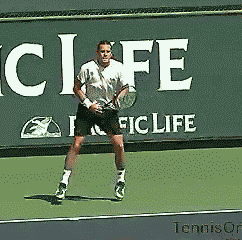
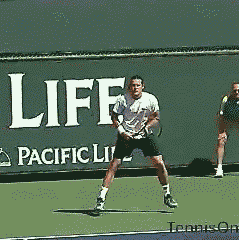


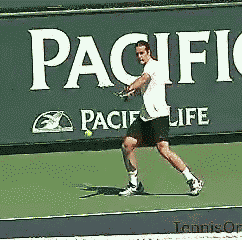
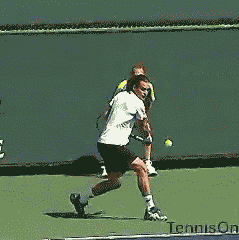
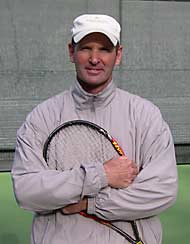
 Doug King studied with legendary tennis coach Tom Stow and was a
former California State Men's Singles Champion
and the former number one men's player of Northern California.
Doug King studied with legendary tennis coach Tom Stow and was a
former California State Men's Singles Champion
and the former number one men's player of Northern California.